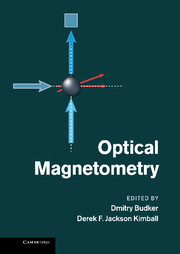Book contents
- Frontmatter
- Contents
- List of contributors
- Preface
- Part I Principles and techniques
- Part II Applications
- 13 Remote detection magnetometry
- 14 Detection of nuclear magnetic resonance with atomic magnetometers
- 15 Space magnetometry
- 16 Detection of biomagnetic fields
- 17 Geophysical applications
- Part III Broader impact
- Index
14 - Detection of nuclear magnetic resonance with atomic magnetometers
from Part II - Applications
Published online by Cambridge University Press: 05 May 2013
- Frontmatter
- Contents
- List of contributors
- Preface
- Part I Principles and techniques
- Part II Applications
- 13 Remote detection magnetometry
- 14 Detection of nuclear magnetic resonance with atomic magnetometers
- 15 Space magnetometry
- 16 Detection of biomagnetic fields
- 17 Geophysical applications
- Part III Broader impact
- Index
Summary
Introduction
Nuclear magnetic resonance (NMR) is a powerful analytical tool for elucidation of molecular form and function, finding application in disciplines including medicine (magnetic resonance imaging), materials science, chemistry, biology, and tests of fundamental symmetries [1–6]. Conventional NMR relies on a Faraday pickup coil to detect nuclear spin precession. The voltage induced in a pickup coil is proportional to the rate of change of the magnetic flux through the coil. Hence, for a given nuclear spin polarization, the signal increases linearly with the Larmor precession frequency of the nuclear spins. Since the thermal nuclear spin polarization is also linear in the field strength, the overall signal is roughly proportional to B2, motivating the development of stronger and stronger magnetic fields. Additionally, an important piece of information in NMR is the so-called chemical shift, which effectively modifies the gyromagnetic ratios of the nuclear spins depending on their chemical environment. This produces different precession frequencies for identical nuclei on different sites of a molecule, and the separation in precession frequencies is linear in the magnetic field. For these reasons, tremendous expense has been spent on the development of stronger magnets. Typical spectrometers feature 9.4 T superconducting magnets, corresponding to 400 MHz proton precession frequencies, and state-of-the-art NMR facilities may feature 24 T magnets, corresponding to 1 GHz proton precession frequency. While the performance of such machines is impressive, there are a number of drawbacks: superconducting magnets are immobile and expensive (roughly §500 000 for a 9.4 T magnet and console) and require a constant supply of liquid helium.
- Type
- Chapter
- Information
- Optical Magnetometry , pp. 265 - 284Publisher: Cambridge University PressPrint publication year: 2013
- 1
- Cited by



